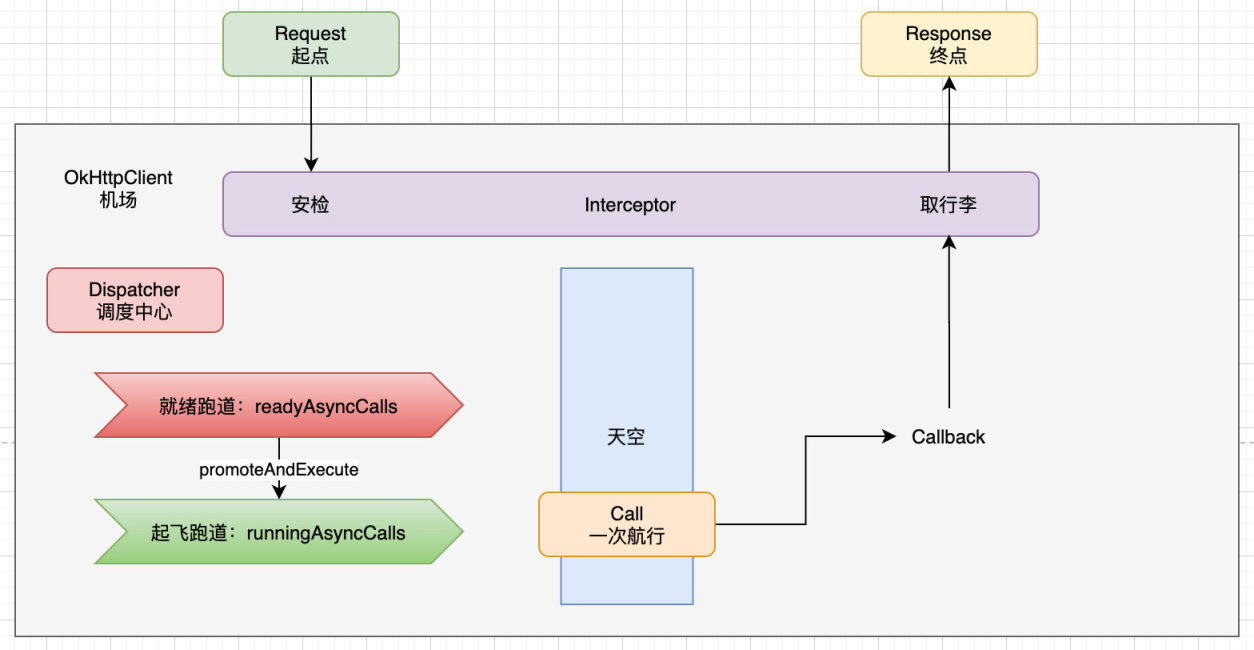嗨,我是哈利迪~《看完不忘系列》将以从树干到细枝的思路分析一些技术框架,本文将对开源项目okhttp网络库进行介绍。
本文约3800字,阅读大约10分钟。如个别大图模糊,可前往个人站点阅读。
概览
源码基于3.14.9,即java版本的最新版
首先上职责图,各个类的名字基本可以见名知意了,就不翻译了,直接起飞~
树干
我们先看一趟飞行的大体流程,
好了,进入代码环节,引入依赖,
implementation 'com.squareup.okhttp3:okhttp:3.14.9'
简单使用(只分析异步请求,同步请求类似),
class OkhttpActivity extends AppCompatActivity {
OkHttpClient mClient = new OkHttpClient();
void onCreate(Bundle savedInstanceState) {
String url = "xxx";
Request request = new Request.Builder().url(url).build();
Call call = mClient.newCall(request);
call.enqueue(new Callback() {
@Override
public void onFailure(Call call, IOException e) {
}
@Override
public void onResponse(Call call, Response response) throws IOException {
String result = response.body().string();
runOnUiThread(() -> {
mBinding.tv.setText(result);
});
}
});
}
}
OkHttpClient和Request使用构建者模式创建即可,当然,如果OkHttpClient不需要进行配置,直接new就行。知道了起点和终点,就可以创建航班Call了,
Call newCall(Request request) {
return RealCall.newRealCall(this, request, false);
}
RealCall newRealCall(OkHttpClient client, Request originalRequest, boolean forWebSocket) {
RealCall call = new RealCall(client, originalRequest, forWebSocket);
call.transmitter = new Transmitter(client, call);
return call;
}
可见Call的实例是RealCall,航班创建好后,进入就绪跑道,
void enqueue(Callback responseCallback) {
transmitter.callStart();
client.dispatcher().enqueue(new AsyncCall(responseCallback));
}
AsyncCall就是一个Runnable,run方法里调了execute方法,
void execute() {
try {
Response response = getResponseWithInterceptorChain();
responseCallback.onResponse(RealCall.this, response);
} catch (IOException e) {
responseCallback.onFailure(RealCall.this, e);
} catch (Throwable t) {
cancel();
IOException canceledException = new IOException("canceled due to " + t);
canceledException.addSuppressed(t);
responseCallback.onFailure(RealCall.this, canceledException);
throw t;
} finally {
client.dispatcher().finished(this);
}
}
AsyncCall里有一个原子计数器,
volatile AtomicInteger callsPerHost = new AtomicInteger(0);
Dispatcher里有两个默认max值,
int maxRequests = 64;
int maxRequestsPerHost = 5;
什么意思呢?可以这么理解,机场的调度中心,限制了同时最多起飞的航班为64班;飞往同一个城市的航班,同时最多只能有5班,为什么做城市限制?跟连接池的复用有关,后面会讲。下面我们以上海为例,
看下enqueue方法做了啥,
enqueue(AsyncCall call) {
synchronized (this) {
readyAsyncCalls.add(call);
if (!call.get().forWebSocket) {
AsyncCall existingCall = findExistingCallWithHost(call.host());
if (existingCall != null) call.reuseCallsPerHostFrom(existingCall);
}
}
promoteAndExecute();
}
跟进promoteAndExecute,
boolean promoteAndExecute() {
List<AsyncCall> executableCalls = new ArrayList<>();
boolean isRunning;
synchronized (this) {
for (Iterator<AsyncCall> i = readyAsyncCalls.iterator(); i.hasNext(); ) {
AsyncCall asyncCall = i.next();
if (runningAsyncCalls.size() >= maxRequests) break;
if (asyncCall.callsPerHost().get() >= maxRequestsPerHost) continue;
i.remove();
asyncCall.callsPerHost().incrementAndGet();
executableCalls.add(asyncCall);
runningAsyncCalls.add(asyncCall);
}
isRunning = runningCallsCount() > 0;
}
for (int i = 0, size = executableCalls.size(); i < size; i++) {
AsyncCall asyncCall = executableCalls.get(i);
asyncCall.executeOn(executorService());
}
return isRunning;
}
其中executorService()返回了一个线程池,
synchronized ExecutorService executorService() {
if (executorService == null) {
executorService =
new ThreadPoolExecutor(0, Integer.MAX_VALUE,
60, TimeUnit.SECONDS,
new SynchronousQueue<>(),
Util.threadFactory("OkHttp Dispatcher", false));
}
return executorService;
}
核心线程数为0,空闲了60秒后,所有线程会被清空;最大线程数无限制,其实还好,已经有调度中心Dispatcher会限制请求数了。
继续跟进executeOn方法,
void executeOn(ExecutorService executorService) {
boolean success = false;
try {
executorService.execute(this);
success = true;
} catch (RejectedExecutionException e) {
InterruptedIOException ioException = new InterruptedIOException("executor rejected");
ioException.initCause(e);
transmitter.noMoreExchanges(ioException);
responseCallback.onFailure(RealCall.this, ioException);
} finally {
if (!success) {
client.dispatcher().finished(this);
}
}
}
可见,回调都在子线程里完成,所以Activity里要切回主线程才能操作UI。至此,核心流程就结束了。
细枝
拦截器链
前边得到Response的地方,调了getResponseWithInterceptorChain,进去看看,
Response getResponseWithInterceptorChain() throws IOException {
List<Interceptor> interceptors = new ArrayList<>();
interceptors.addAll(client.interceptors());
interceptors.add(new RetryAndFollowUpInterceptor(client));
interceptors.add(new BridgeInterceptor(client.cookieJar()));
interceptors.add(new CacheInterceptor(client.internalCache()));
interceptors.add(new ConnectInterceptor(client));
if (!forWebSocket) {
interceptors.addAll(client.networkInterceptors());
}
interceptors.add(new CallServerInterceptor(forWebSocket));
Interceptor.Chain chain =
new RealInterceptorChain(interceptors, transmitter, null, 0,
originalRequest, this, client.connectTimeoutMillis(),
client.readTimeoutMillis(), client.writeTimeoutMillis());
Response response = chain.proceed(originalRequest);
return response;
}
拦截器链基于责任链模式,即不同的拦截器有不同的职责,链上的拦截器会按顺序挨个处理,在Request发出之前,Response返回之前,插入一些定制逻辑,这样可以方便的扩展需求。当然责任链模式也有不足,就是只要一个环节阻塞住了,就会拖慢整体运行(效率);同时链条越长,产生的中间对象就越多(内存)。
我们先跟proceed方法,
Response proceed(Request request, Transmitter transmitter,Exchange exchange)
throws IOException {
RealInterceptorChain next =
new RealInterceptorChain(interceptors, transmitter, exchange,
index + 1, request, call, connectTimeout,
readTimeout, writeTimeout);
Interceptor interceptor = interceptors.get(index);
Response response = interceptor.intercept(next);
return response;
}
下面简要分析下各个拦截器的功能。
一、RetryAndFollowUpInterceptor:
负责重试和重定向。
static final int MAX_FOLLOW_UPS = 20;
Response intercept(Chain chain) throws IOException {
Request request = chain.request();
RealInterceptorChain realChain = (RealInterceptorChain) chain;
Transmitter transmitter = realChain.transmitter();
int followUpCount = 0;
while (true) {
transmitter.prepareToConnect(request);
Response response = realChain.proceed(request, transmitter, null);
Request followUp = followUpRequest(response, route);
if (followUp == null) {
return response;
}
RequestBody followUpBody = followUp.body();
if (followUpBody != null && followUpBody.isOneShot()) {
return response;
}
if (++followUpCount > MAX_FOLLOW_UPS) {
throw new ProtocolException("Too many follow-up requests: " + followUpCount);
}
request = followUp;
}
}
其中followUpRequest方法会根据Response不同的响应码做相应的处理,就不跟了。
二、BridgeInterceptor:
桥接,负责把应用请求转换成网络请求,把网络响应转换成应用响应,说白了就是处理一些网络需要的header,简化应用层逻辑。
Response intercept(Chain chain) throws IOException {
Request userRequest = chain.request();
Request.Builder requestBuilder = userRequest.newBuilder();
RequestBody body = userRequest.body();
if (body != null) {
requestBuilder.header("Content-Type", contentType.toString());
}
Response networkResponse = chain.proceed(requestBuilder.build());
Response.Builder responseBuilder = networkResponse.newBuilder()
.request(userRequest);
return responseBuilder.build();
}
这里需要注意的一点是,在服务器支持gzip压缩的前提下,客户端不设置Accept-Encoding=gzip的话,okhttp会自动帮我们开启gzip和解压数据,如果客户端自己开启了gzip,就需要自己解压服务器返回的数据了。
三、CacheInterceptor:
负责管理缓存,使用okio读写缓存。
InternalCache cache;
Response intercept(Chain chain) throws IOException {
Response cacheCandidate = cache != null
? cache.get(chain.request())
: null;
CacheStrategy strategy =
new CacheStrategy.Factory(now, chain.request(), cacheCandidate).get();
Request networkRequest = strategy.networkRequest;
Response cacheResponse = strategy.cacheResponse;
if (networkRequest == null && cacheResponse == null) {
return new Response.Builder().code(504).xxx.build();
}
if (networkRequest == null) {
return cacheResponse.newBuilder()
.cacheResponse(stripBody(cacheResponse)).build();
}
Response networkResponse = chain.proceed(networkRequest);
if (cacheResponse != null) {
if (networkResponse.code() == HTTP_NOT_MODIFIED) {
Response response = cacheResponse.newBuilder().xxx.build();
cache.update(cacheResponse, response);
return response;
}
}
Response response = networkResponse.newBuilder().xxx.build();
cache.put(response);
return response;
}
关于缓存策略CacheStrategy会在缓存章节展开。
四、ConnectInterceptor:
负责创建连接Connection。
Response intercept(Chain chain) throws IOException {
RealInterceptorChain realChain = (RealInterceptorChain) chain;
Request request = realChain.request();
Transmitter transmitter = realChain.transmitter();
boolean doExtensiveHealthChecks = !request.method().equals("GET");
Exchange exchange = transmitter.newExchange(chain, doExtensiveHealthChecks);
return realChain.proceed(request, transmitter, exchange);
}
newExchange方法会在连接池章节展开。
五、CallServerInterceptor:
负责写请求和读响应。
Response intercept(Chain chain) throws IOException {
RealInterceptorChain realChain = (RealInterceptorChain) chain;
Exchange exchange = realChain.exchange();
Request request = realChain.request();
exchange.writeRequestHeaders(request);
Response.Builder responseBuilder = null;
responseBuilder = exchange.readResponseHeaders(false);
Response response = responseBuilder
.request(request)
.handshake(exchange.connection().handshake())
.sentRequestAtMillis(sentRequestMillis)
.receivedResponseAtMillis(System.currentTimeMillis())
.build();
response = response.newBuilder()
.body(exchange.openResponseBody(response))
.build();
return response;
}
缓存
缓存的实现是基于请求和响应的header来做的。CacheStrategy即缓存策略,CacheInterceptor拦截器会根据他拿到网络请求networkRequest、缓存响应cacheResponse,从而决定是使用网络还是缓存。
static class Factory {
Factory(long nowMillis, Request request, Response cacheResponse) {
this.nowMillis = nowMillis;
this.request = request;
this.cacheResponse = cacheResponse;
if (cacheResponse != null) {
this.sentRequestMillis = cacheResponse.sentRequestAtMillis();
Headers headers = cacheResponse.headers();
for (int i = 0, size = headers.size(); i < size; i++) {
String fieldName = headers.name(i);
String value = headers.value(i);
if ("Date".equalsIgnoreCase(fieldName)) {
servedDate = HttpDate.parse(value);
servedDateString = value;
} else if (xxx){
}
}
}
}
CacheStrategy get() {
CacheStrategy candidate = getCandidate();
if (candidate.networkRequest != null && request.cacheControl().onlyIfCached()) {
return new CacheStrategy(null, null);
}
return candidate;
}
CacheStrategy getCandidate() {
return new CacheStrategy(xxx);
}
}
getCandidate里面就是根据header字段得到各种策略,然后交给拦截器处理,感兴趣的读者自行阅读啦。
那么缓存是如何写入磁盘的呢?跟进InternalCache接口,他的实现在Cache类里,
InternalCache internalCache = new InternalCache() {
@Override public Response get(Request request) throws IOException {
return Cache.this.get(request);
}
@Override public CacheRequest put(Response response) throws IOException {
return Cache.this.put(response);
}
};
Response get(Request request) {
String key = key(request.url());
DiskLruCache.Snapshot snapshot;
Entry entry;
snapshot = cache.get(key);
if (snapshot == null) {
return null;
}
entry = new Entry(snapshot.getSource(ENTRY_METADATA));
Response response = entry.response(snapshot);
return response;
}
CacheRequest put(Response response) {
String requestMethod = response.request().method();
if (!requestMethod.equals("GET")) {
return null;
}
Entry entry = new Entry(response);
DiskLruCache.Editor editor = null;
editor = cache.edit(key(response.request().url()));
entry.writeTo(editor);
return new CacheRequestImpl(editor);
}
okhttp的DiskLruCache,就是根据最近最少使用算法,来管理磁盘缓存,他和Glide里的DiskLruCache有几份相似,比如日志处理都一样,内部都有一个线程池来清理磁盘,不过okhttp有用到okio。感兴趣的读者可以留意下okhttp3.internal.cache.DiskLruCache和com.bumptech.glide.disklrucache.DiskLruCache。
注:缓存默认是关闭的,需要自行开启:
new OkHttpClient.Builder()
.cache(new Cache(new File(MyApp.APP.getCacheDir(), "okhttp_cache"),
50L * 1024L * 1024L))
.build();
连接池
还记得Transmitter吗,前面我们叫他机长,他是应用和网络之间的桥梁,管理着连接、请求、响应和流。在拦截器章节知道:
RetryAndFollowUpInterceptor里调了transmitter.prepareToConnect;准备一个连接
ConnectInterceptor里调了transmitter.newExchange;创建一个交换器
这里补充几个概念:
Connection,实现为RealConnection:连接,抽象概念,内部维护了Socket
>
ConnectionPool,持有RealConnectionPool:连接池,管理连接的复用
>
Exchange:交换器(管理请求和响应、持有ExchangeCodec)
>
ExchangeCodec:编解码器,用于编码请求,解码响应,实现有Http1ExchangeCodec和Http2ExchangeCodec
>
HTTP 1.1:引入keep-alive机制,支持连接保活,可以多个请求复用一个连接,但请求是串行的
>
HTTP 2.0:支持多路复用,一个连接的多个请求可以并行
先看RealConnectionPool,
Executor executor =
new ThreadPoolExecutor(0,Integer.MAX_VALUE,60L,TimeUnit.SECONDS,
new SynchronousQueue<>(),
Util.threadFactory("OkHttp ConnectionPool", true));
int maxIdleConnections;
long keepAliveDurationNs;
Deque<RealConnection> connections = new ArrayDeque<>();
boolean transmitterAcquirePooledConnection(Address address, Transmitter transmitter,
List<Route> routes, boolean requireMultiplexed) {
for (RealConnection connection : connections) {
if (requireMultiplexed && !connection.isMultiplexed()) continue;
if (!connection.isEligible(address, routes)) continue;
transmitter.acquireConnectionNoEvents(connection);
return true;
}
return false;
}
long cleanup(long now) {
synchronized (this) {
for (Iterator<RealConnection> i = connections.iterator(); i.hasNext(); ) {
if (idleDurationNs > longestIdleDurationNs) {
longestIdleDurationNs = idleDurationNs;
longestIdleConnection = connection;
}
}
if (longestIdleDurationNs >= this.keepAliveDurationNs
|| idleConnectionCount > this.maxIdleConnections) {
connections.remove(longestIdleConnection);
}
}
closeQuietly(longestIdleConnection.socket());
}
RealConnection代码有点多,知道他内部维护了Socket就行了。
前面提到过,同一主机的同时请求数被限制成maxRequestsPerHost = 5 ,为什么这么做?同主机的请求可以共用一个连接,所以大概是为了限流?比如同时飞往上海的航班如果不限数量,会把上海机场挤爆?有知道答案的小伙伴留下评论呀~
小结
okhhttp具有以下优势:
尾声
还是那句话,该系列旨在摸清技术的整体实现思路,okhhttp里还有很多精彩细节,如cookie、route、dns、tls等处理,本文没有提到,大家还是要对着源码学习呀。哈迪在看源码过程还发现了很多不懂的地方,比如各种协议和标准,这也是个补充网络知识的好机会,一起飞~
系列文章:
参考资料

















评论